

Travelogue
Into the Promised Land
by Norman Bituin
"Into The Promised Land" is the name of the the "15 days inspirational journey to Egypt, Jordan & Israel" that my wife Cherry and I took in Oct. 2015. We joined the tour operated by America Israel Travel with Cherry's co-nurses and several groups of people all over the US. As a believer, the Holy Land has always been my ultimate dream destination, the top on my bucket list of "Must See Places Before You Die".
As you know from reading my previous Travelogue articles, I have not, until now, joined a guided tour preferring to wing it on my own. However, this one we had to for two reasons. First, the geography, subject matter and history are so extensive that the knowledge a certified, professional guide would provide is invaluable. As it turned out, we had a perfect balance. In Egypt, our guide was a Muslim; in Jordan, a Catholic; and in Israel, a Jew who fought in the Six-Day War and whose specialization in his doctoral from Hebrew University was early Christian civilization. Second, for security reasons it was more reassuring. In Egypt and Jordan, every tour bus had an armed police officer seating in front near the door checking everyone in and out of the bus. Crossing the Sinai Desert to the Golan Heights, our convoy of three buses was escorted by a jeepload of armed personnel who surrounded the perimeter when we stopped to take a break and eat. In Israel, there were army/police patrols on the streets and major tourist sites - even as we were watching the spate of stabbings and violence in Jerusalem and the West Bank on BBC News at the hotel.
Before the Promised Land tour though, I did my own freewheeling style of travel. I spent 11 days backpacking alone in Greece and Turkey. I flew out of Istanbul and met Cherry and the rest of the tour group in Cairo.
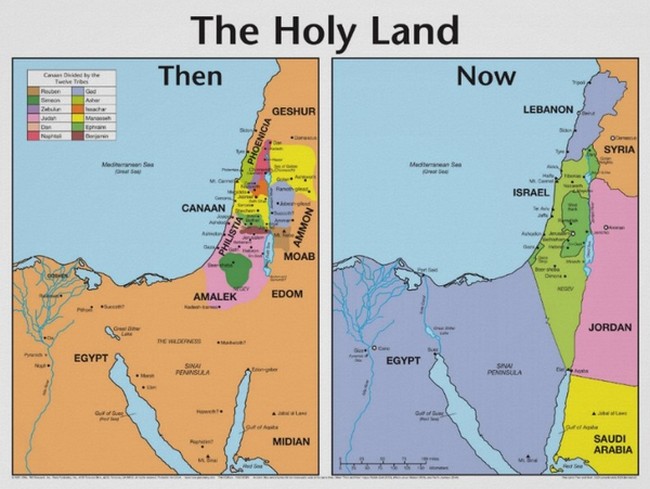
I. Egypt
Giza - Cairo
The Giza Pyramids: Pyramid of Khufu (also known as the "Great Pyramid"), the Pyramid of Khafre and the Pyramid of Menkaure.
Built in 2580-2560 BC as a tomb for Fourth Dynasty Egyptian pharaoh Khufu, the accuracy of the pyramid's
workmanship is such that the four sides of the base have an average error of only 58 millimetres in length.
For a couple of bucks, the camel attendant would take this trick shot with your camera (see riders on the right).
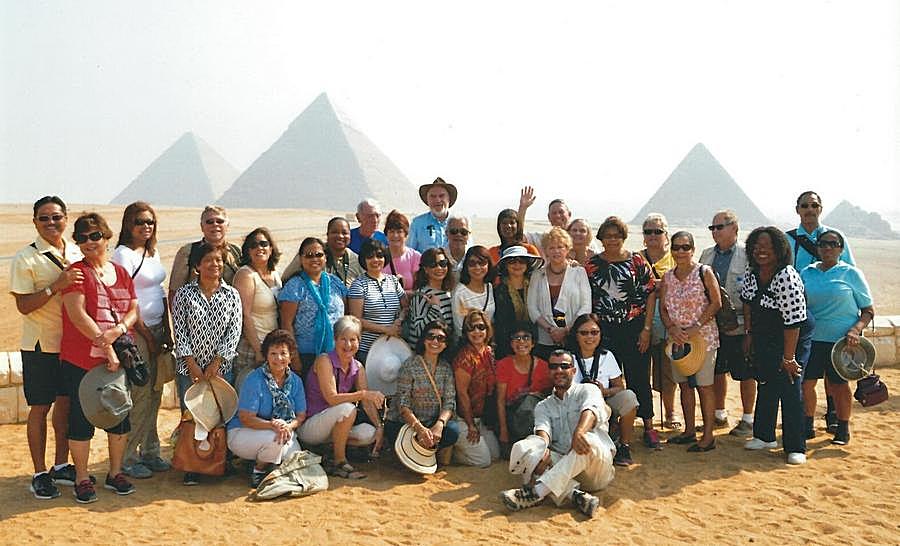
This is our group picture by the official photographer from America Israel Travel. Yasser, our tour guide, seats in front.
The Great Sphinx of Giza is the largest monolith statue in the world built approximately in 2500 BC for the pharaoh Khafra.
Route of the Biblical Exodus: book of Exodus written by Moses around 1450-1410 BC where he led his people out of bondage in Egypt.
Saints Sergius and Bacchus Coptic Church built in the 4th century is traditionally believed to have been built on the spot where the Holy Family, Joseph, Mary and
the infant Jesus Christ, rested at the end of their journey into Egypt (depicted on mosaic wall). They may have lived here while Joseph worked at the fortress.
Tahrir Square was the site where the crowd gathered during the 2011 Egyptian Revolution that ousted President Hosni Mubarak.
Our guide said they had no tourists and income for 4 years after the revolution and asked us to tell friends to come.
The Museum of Egyptian Antiquities houses the world’s largest collection of Pharaonic antiquities. (No photography allowed).
Sinai Desert
Convoy of tour buses cross the vast Sinai Desert escorted by a jeepload of armed guards (taken with 600mm telephoto). Our bus was detained when someone took
picture of army checkpoint. Three weeks after we got back to US, Russian Metrojet Flight 9268 went down in Sinai Desert from a bomb with all 244 people aboard killed.
Mount Sinai
Dinner in a Bedouin tent before the (optional) ascent to Mount Sinai. Those who chose not to or thought that they physically could not do it stayed in the hotel to sleep.
(There was an option to ride a camel 2/3 of the way $25). We started the climb from the base at 4,000 feet at 1 AM and reached the top at 7,500 feet before sunrise.
It was completely dark and we were using only flashlights to walk the trail with a Bedouin guide. We were exhilarated at the top to watch the beatiful sunrise.
According to Jewish, Christian and Islamic tradition, the biblical Mount Sinai was the place where Moses received the Ten Commandments.
EXODUS 34:27-28.Then the LORD said to Moses, "Write down these words, for in accordance with these words
I have made a covenant with you and with Israel." So he was there with the LORD forty days and forty nights;
he did not eat bread or drink water. And he wrote on the tablets the words of the covenant, the Ten Commandments.
Here's how the mountain trail looks on the way down during daytime.
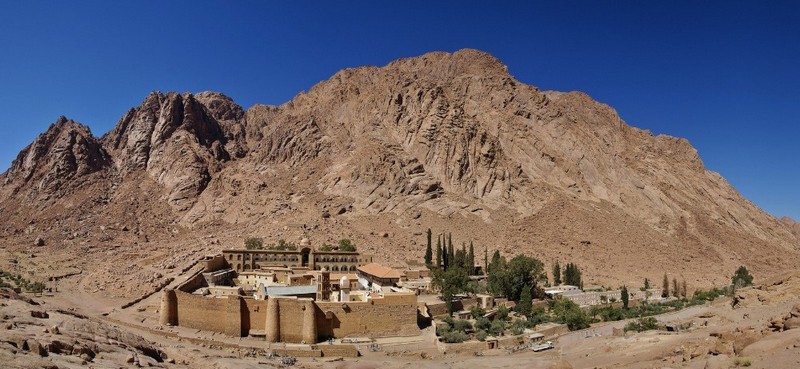
From the top of Mount Sinai we hiked back down to St. Catherine's Monastery for the bus ride back to the hotel in time for breakfast.
[This is an online photo.]
II. Jordan
Amman
The morning routine: after a full breakfast (dinner also included in package) in 5-star hotel, tour buses pull in and porters start loading the luggages.
We met two young, pretty Filipino food servers. Regarding foreign nurses, our guide said that only Filipino nurses are hired because of their reputation.
A roadside picture of the Royal Family: King Hussein (died 1999), King Abdullah and Crown Prince Hussein.
Petra
The Siq (Canyon)
Petra, established as early as 312 BC as the rock-cut capital city of the Arab Nabateans, is half-built, half-carved into the rock and is
surrounded by mountains riddled with passages and gorges. It became during Hellenistic and Roman times a major caravan centre. It
is a UNESCO World Heritage Site and has been chosen by the Smithsonian Magazine as one of the "28 Places to See Before You Die".
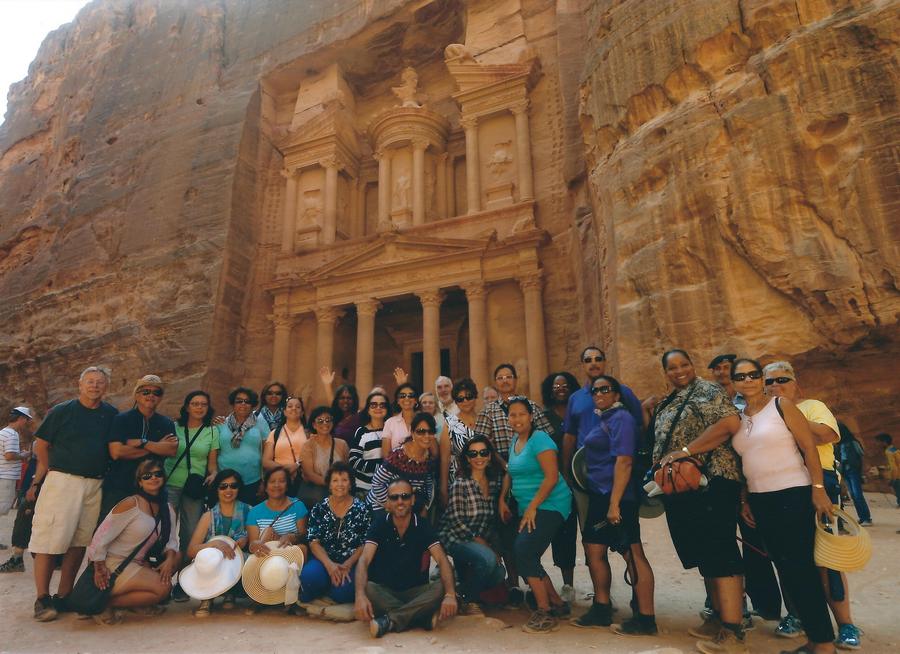
This is our group picture by the official photographer from America Israel Travel. Sam, our tour guide, seats in front.
Mount Nebo
According to Christian tradition, Moses was buried on the mountain.
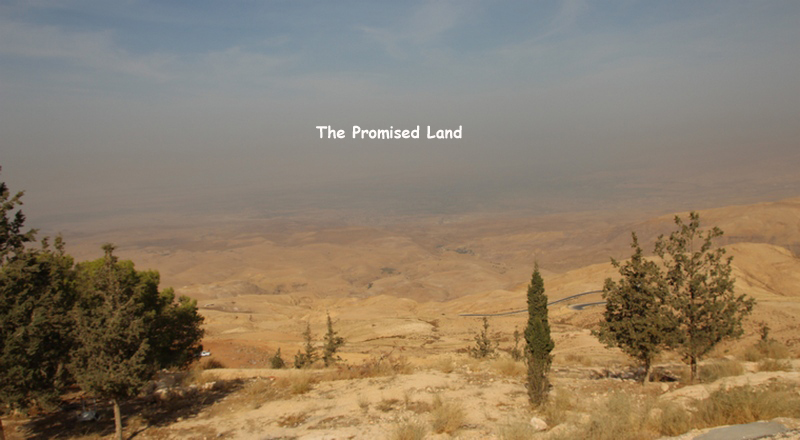
In the Book of Deuteronomy, Moses ascended Mount Nebo to view the Promised Land.
Madaba
The Greek Orthodox Church of St. George has the earliest original map, 560 AD, of the Holy Land.
A former nurse supervisor in California, Joan poses with Jordanian police and walks with our bus escort, a tourist police.
III. Israel
Caesaria Maritima
The ancient Caesarea Maritima city and harbor was built by Herod the Great about 25–13 BC in honor of Augustus Caesar.
Megiddo or Armageddon
Armageddon will be, according to the Book of Revelation,
the site of a gathering of armies for a battle during the end times.
Mount Precipice - Nazareth
Also known as Mount of Precipitation or Mount of the Leap, it is believed by many to be the site of the Rejection of Jesus described in Luke 4:29-30
Basilica of Annunciation - Nazareth
The church was established at the site where, according to Roman Catholic tradition, the Annunciation took place. The first shrine was built in the middle of the 4th
century and destroyed in the 7th century after the Muslim conquest of Palestine. The second church was built during the Crusades but Baybars destroyed the
church during in 1260 their attack on Nazareth. The Basilica gallery has mosaics representing some of the most important Marian devotions in different countries.
Spain France Australia
Canada Japan United States
Brazil Mexico Poland
Cana of Galilee
Cana of Galiee is known as the place where, according to the Fourth Gospel, Jesus performed his first public miracle, the turning
of a large quantity of water into wine at a wedding feast (John 2:1–11) when the wine provided by the bridegroom had run out.
Mount of Beatitudes
Located on a small hill overlooking the Sea of Galilee near Tabgha, the Mount of Beatitudes is the
traditional site of Jesus' delivery of the Sermon on the Mount, probably the most famous sermon of all time.
We met three Filipino priests on their way to say mass at the church.
Capernaum
Jesus selected this town as the center of his public ministry in the
Galilee after he left the small mountainous hamlet of Nazareth (Matthew
4:12–17).
One Sabbath, Jesus taught in the synagogue in Capernaum and
healed a man who was possessed by an unclean spirit (Luke 4:31–36, Mark
1:21–28).
Sea of Galilee
Our tour guide, Isaac, an army soldier who fought in the Six-Day War and who has a doctoral degree with specialization in early Christian history,
gave us excellent lessons in religion and history, even teaching us a Jewish dance on the boat ride, reminiscent of the time of Jesus, in the Sea of Galilee.
The Sea of Galilee Boat, also known as the Jesus Boat, was an ancient fishing boat from the
1st century AD, discovered in 1986 on the north-west shore of the Sea of Galilee in Israel.
Yardenit Baptismal Site in Galilee
I looked "odd" here without the white garment but I wanted, as in Mt. Sinai, to take Malmon with me to the baptism.
Dead Sea
The Dead Sea is a salt lake and was one of the world's first health resorts (for King Herod). Water density is 1.24 kg/litre, which makes swimming similar to floating.
Bet Shea'an National Park
Beit She’an was first settled 5000-6000 years ago. The city has had many
conquerors, among them the Egyptians, the Philistines,
Assyrians,
Greeks, Romans, Muslims, the Crusaders, Mamluk and Ottoman. A tour of Beit
She’an is like a walk through time.
The ladies try the public latrine for size - and comfort? And sorry, no privacy.
Masada
Herod the Great built palaces for himself on the mountain and fortified Masada between 37-31 BCE. The Siege of Masada in 73 CE by troops of the
Roman Empire towards the end of the First Jewish–Roman War ended in the mass suicide of 960 people – the Sicarii rebels and their families hiding there.
A giant siege tower with a battering ram was constructed and moved up the completed ramp on this side.
Qumran Caves
The Dead Sea Scrolls were hidden in caves and initially found by a Bedouin shepherd in 1946.
The scrolls have traditionally been identified with the ancient Jewish sect called the Essenes.
Nearly 900 scrolls were discovered. They contained evidence of speeches by Jesus and ancient Jewish prayers.
Most of the texts are written in Hebrew, with some in Aramaic, in different regional dialects and a few in Greek.
Mount of Olives overlooking Jerusalem
The Dome of the Rock is a shrine located on the Temple Mount in the Old City of Jerusalem and was completed in 691 CE.
According to some Islamic scholars, the rock is the spot from which the Islamic prophet Muhammad ascended to Heaven
accompanied by the angel Gabriel. Further, Muhammad was taken here by Gabriel to pray with Abraham, Moses, and Jesus.
Gethsemane
Church of All Nations (Basilica of the Agony) is a church at Gethsemane built over the rock on which Jesus
is believed to have prayed in agony the night before he was betrayed by Judas Iscariot and arrested.
The garden of Gethsemane, near Mount of Olives, is named in the New Testament where Jesus went with his disciples to pray the night before he was crucified.
Room of the Last Supper
Cenacle, also known as the "Upper Room", is a room in Jerusalem traditionally held to be
the site of The Last Supper and the usual place where the Apostles stayed in Jerusalem.
The Western Wall / Temple Mount
The Western Wall or Wailing Wall is considered holy due to its connection to the Temple Mount.
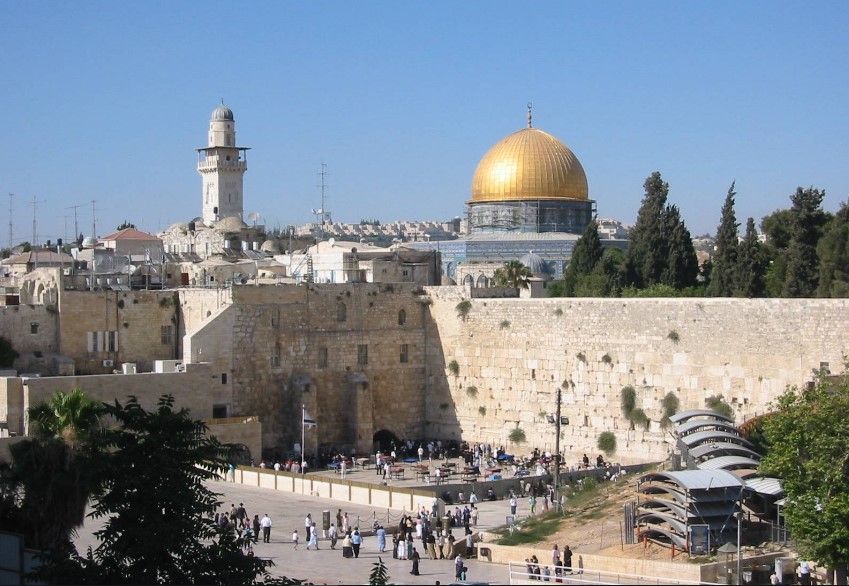
[This is an online photo.]
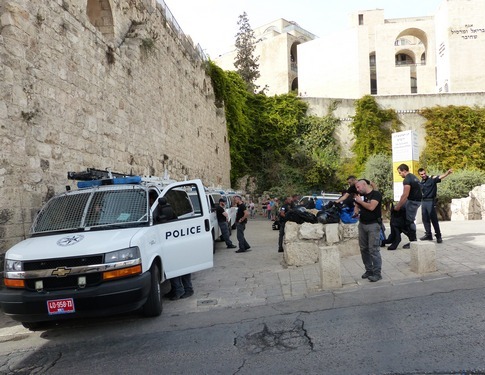
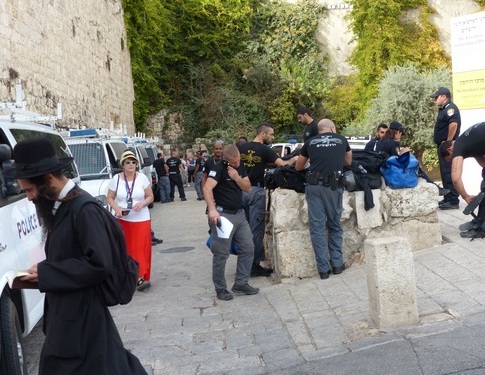
Police surround the area
The Temple Mount, a hill located in the Old City of Jerusalem, has been venerated as a holy site for thousands of years by Judaism, Christianity, and Islam.
Church of Nativity (Birth Place of Jesus) - Bethlehem
The church was originally commissioned in 327 by Constantine the Great over the site that is still traditionally considered to be located over
the cave that marks the birthplace of Jesus of Nazareth. It was destroyed by fire during the Samaritan Revolts in the 6th century. A new
basilica was built in 565 by Justinian, the Byzantine Emperor. It is a World Heritage Site and was the first to be listed under Palestine.
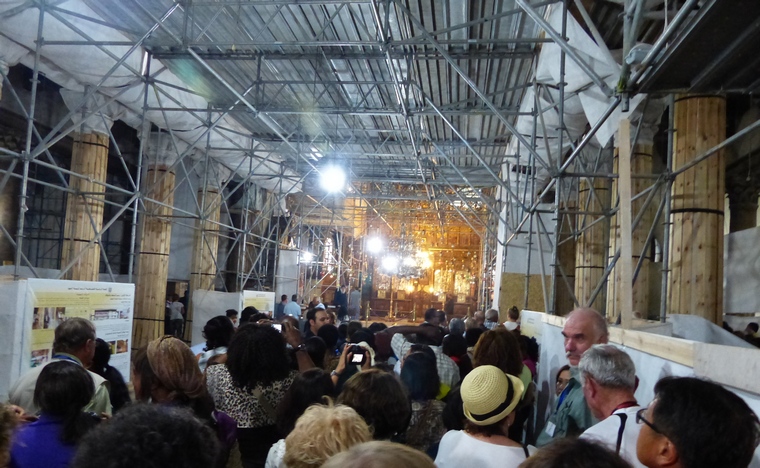
For 2015-2016, the church is going through a lot of improvement and construction.
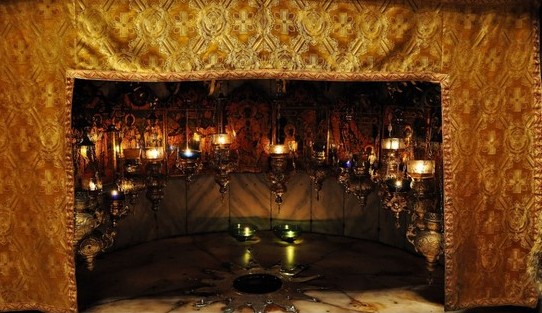
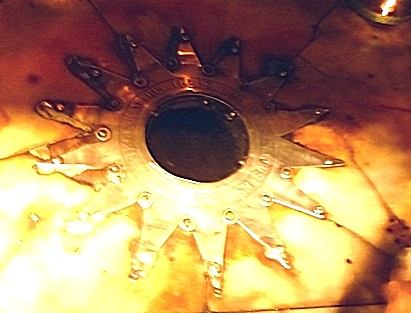
The Grotto of the Nativity, an underground cave located beneath the basilica, enshrines the site where Jesus is said to have been born.
The exact spot is marked beneath an altar by a 14-pointed silver
star set into the marble floor and surrounded by fifteen silver lamps.
Church of St. Anne (Birth Place of Virgin Mary) - Jerusalem
The Church of St Anne followed sometime between 1131-1138. It was erected over the site of a grotto believed to be the childhood home
of the Virgin Mary, mother of Jesus. It is dedicated to Anna and Joachim, the parents of Saint Mary, who according to tradition lived here.
Via Dolorosa
1st Station - Jesus is condemned to death
Prison of Christ
3rd Station - Jesus falls the first time 4th Station - Jesus meets his mother
5th Station - Simon of Cyrene helps Jesus carry the cross
8th Station - Jesus meets the women of Israel
9th Station - Jesus falls the third time 10th Station - Jesus is stripped of his garments
Church of the Holy Sepulchre
The church contains the two holiest sites in Christendom: the site where Jesus of Nazareth was crucified known as "Calvary" in Latin
and "Golgotha" in Greek, and Jesus' empty tomb, where he is said to have been buried and resurrected. Within the church proper
are the last four (or, by some definitions, five) Stations of the Via Dolorosa, representing the final episodes of Jesus' Passion.
Going inside Golgotha (sign above)
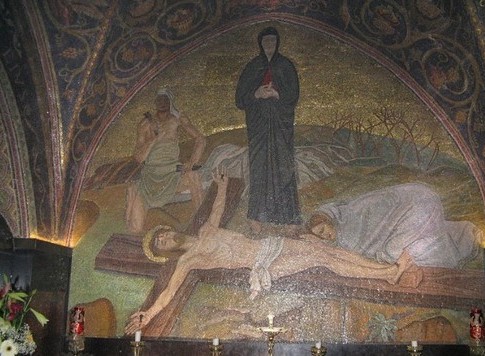
11th Station - Jesus is nailed to the cross 12th Station - Jesus dies on the cross
13th - Jesus is taken down from the cross
Stone of the Anointing (or Unction), in memory of the piety of Nicodemus and Joseph of Arimathea, who prepared Jesus’ body for burial.
This is our group picture at the Church of Holy Sepulchre.
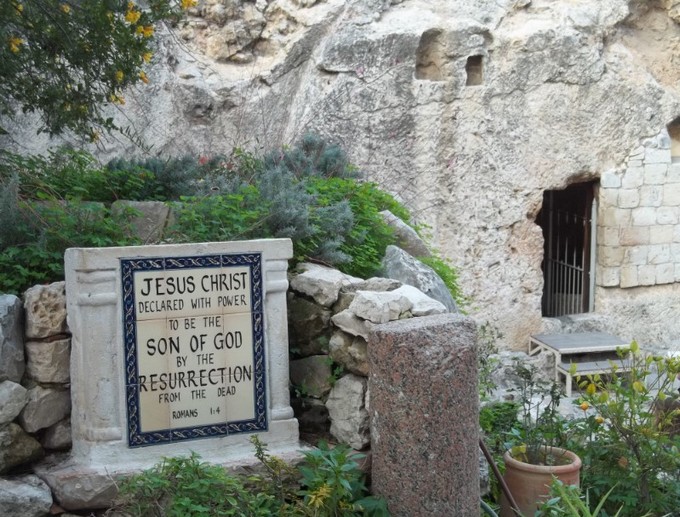
14th Station - Jesus is laid in the tomb
The Garden Tomb is a rock-cut tomb in Jerusalem adjacent to a rocky escarpment unearthed in 1867 and
has subsequently been considered by some Christians to be the site of the burial and resurrection of Jesus.
15th Station - Jesus rises from the dead ("He Is Not Here For He Is Risen")
Isaac, our tour guide (seated leftmost) from America Israel Travel, joins us on our farewell dinner.
Tel Aviv
Cherry's group departed Israel back to the US on time. My flight was canceled due to a lightning strike on the aircraft and unfortunately
(or fortunately) I had to stay two nights and a day, all expenses paid. I walked a lot, in fact my Fitbit showed I logged over 30,000 steps.
The 5-star hotels line up the seaside promenade.
Carmel Market, a busy marketplace, is tightly guarded by army patrol.
Old Jaffa Flea Market
Old Jaffa is an ancient port city famous for its association with the biblical stories of Jonah, Solomon, and Saint Peter.
A sculpture on a park along the seaside promenade
A wedding by the beach
Surfing and badminton on the beach
Jogging at sunset in Tel Aviv
Nighttime frolic and play at the beach
Shalom, Israel
~~~~~~~~~~~~~~~~~~~~~~~~~~~~~~~~~~~~~~~~~~~~~~~~~~~~~~
Since I have the time after retiring last year, I decided to take a solo trip before the group tour in the Holy Land. I know Willie "Tatang" and Tess Vergara did Turkey and Greece the year before and had enjoyed themselves. With that, plus the fact that these countries are in close proximity to the tour (I only added $270 in airfare using Turkish Airlines), I got my backpack and camera bag and hit the road early - 4 days in Greece, 7 days in Turkey. Tatang had already published an exhaustive travel article on Turkey in Travelogue ("Turkey: A Destination Worth Your While") and will be releasing one for Greece too. In this segment, therefore, I will mostly just share pictures of my freewheeling jaunt in Greece and Turkey.
Leaving LAX with my backpack (10 shirts, 2 blue jeans) and camera bag (Leica V-LUX 4, Canon T3i)
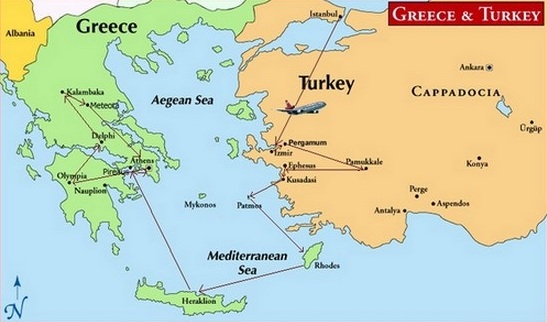
IV. Greece
Athens
Athens International Airport is in subway system which makes it really convenient.
Monastiraki metro station is a 10 minute walk to my budget B&B.
Agora near Monastiraki station
Athens Flea Market
Listening to local musicians and enjoying Greek kebap and beer
I always use the hop on/hop off sightseeing bus - a cheap and practical way to orient and see the major sites.
The Parthenon
Hadrian's Arch Temple of Olympian Zeus
Getting a souvenir shirt at flea market and having dinner at sidewalk resto with lighted Parthenon at back
The Greek Parliament and changing of guards
National Archaeological Museum of Athens
Bronze statue of a boy and a young jockey, about 140 BC Bronze statue of Zeus or Poseidon, about 460 BC
Jewellery from Mycenae graves, 16th century BC Late Helladic pottery, late 15th-early 14th centuries BC
Santorini
I walked 5 hours from Fira to Imerovigli and back.
Some of Santorini's hills are steep, but the view is spectacular.
On the horizon - right of center, you can see the blue top dome of a church. And on next picture...
I am here now standing on top of the church.
One option is to ride the burro.
I turned around here at Imerovigli back to Fira, near a pre-school with some kids playing in the yard.
Love locks hang at the iron bars while a newlywed couple pose for a shot.
V. Turkey
Cappadocia
Cappadocia in Central Anatolia Region contains several underground cities used by early Christians as hiding places.
Some people actually live in these cave houses.
Fairy Chimneys rock formation arose from ancient volcanic eruptions 3-9 million years ago.
Silk worms turn into some of the more expensive Turkish rugs.
I stayed in a cave hotel in Cappadocia.
From the rooftop of the cave hotel with owner Ibrahim Yilmaz, I watched the hot-air balloon ride.
Pamukkale
Pamukkale in Inner Aegean region contains hot springs, travertines and terraces of carbonate minerals.
Hierapolis, an ancient Greco-Roman and Byzantine city, and Necropolis (cemetery).
Roman Theatre
Ephesus
Mary, the mother of Jesus, was taken to this stone house by Saint John and lived there until her Assumption.
Ephesus, a Greco-Roman city, built in the 10th century BC was one of the seven churches of Asia that are cited in the Book of Revelation.
Ampitheatre
Temple of Artemis completed 550 BC is one of the 7 Wonders of the Ancient World. It was completely rebuilt three times before its eventual destruction in 401 AD.
At left is an artist's rendition of what it might have looked like. At right is all that remains at present in the town of Selcuk near Ephesus.
Istanbul
Istanbul, also known as Constantinople and Byzantium, founded around 660 BCE is Turkey's economic and cultural center.
The Sultan Ahmet Mosque, popularly known as the Blue Mosque, was built from 1609-1616 by Sultan Ahmet I.
Hagia Sophia was built originally as a church between 532-537 AD and is now a museum.
Topkapi Palace, one of the major residences of the Ottoman sultans for 400 years, and the Harem Room.
Basilica Cistern was constructed in 6th century AD during the reign of Emperor Justinianus.
Grand Bazaar and Egyptian/Spice Bazaar
Istanbul hop on/hop off bus crosses the Yavuz Sultan Selim Bridge on the Bosphorus that connects the Asian and European sides of Istanbul.
Crossing the two continents of Asia and Europe on the Bosphorus
Galata Bridge - cast fishing over the bridge, seafood restos under the bridge.
Taksim Square
Brods, I know what you're thinking. Yes, the Turkish pretzels are good.